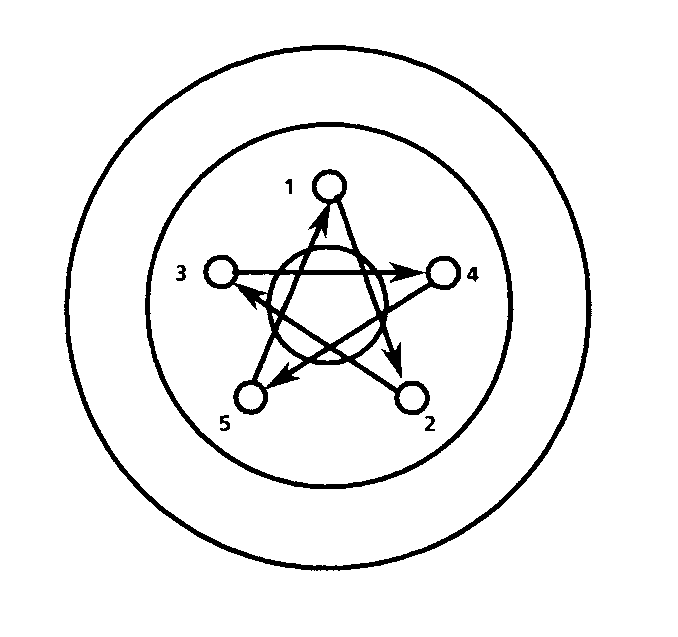Caution: If penetrating oil gets on the vertical surfaces between the wheel and the rotor or drum it could cause the wheel to work loose as the vehicle is driven, resulting in loss of control and an injury accident.
Notice: Never use heat to loosen a tight wheel. It can shorten the life of the wheel, studs, or hub and bearing assemblies. Wheel nuts must be tightened in sequence and to the specified torque to avoid bending the wheel or rotor.
Penetrating oil is not effective in removing tight wheels. However, if used, apply the penetrating oil sparingly to the hub surface only.
Excessive force, such as hammering the wheel or the tire, may cause damage. Lightly tap the tire's sidewall with a rubber mallet.
Sometimes wheels may be difficult to remove from the vehicle due to foreign material or a tight fit between the wheel center hole and the hub or rotor. Use the following procedure in order to safely remove the wheel:
Removal Procedure
- Tighten all of the wheel nuts on the affected wheel.
- Loosen each wheel nut 2 turns.
- Lower the vehicle onto the floor.
- Rock the vehicle from side to side as hard as possible using one or more person's body weight to loosen the wheel.
- Rock the vehicle from Drive gear to Reverse gear allowing the car to move several feet in each direction. Apply quick, hard jabs on the brake pedal in order to loosen the wheel.
- Raise and support the vehicle. Refer to Lifting and Jacking the Vehicle in General Information.
- Remove the hub cap.
- Remove the wheel nuts.
- Mark the location of the tire and wheel to the hub.
- Remove the tire and wheel assembly.
- Clean the following components:
Caution: Before installing the wheels, remove any buildup of corrosion on the wheel mounting surface and brake drum or disc mounting surface by scraping and wire brushing. Installing wheels with poor metal-to-metal contact at the mounting surfaces can cause wheel nuts to loosen. This can cause a wheel to come off when the vehicle is moving, causing loss of control and possibly personal injury.
| • | The wheel nuts |
| • | The studs |
| • | The wheel |
| • | The rotor mounting surfaces |
Installation Procedure
- Install the hub cap on the aluminum wheel, if removed.
- Install the tire and wheel assembly. Align the locating mark of the tire and wheel to the hub assembly.
- Install the wheel nuts.
- Install the wheel cover, if equipped.
- Lower the vehicle.

Caution: Never use oil or grease on studs or nuts. Tighten the wheel nuts with your fingers until they are snug. Then, tighten the nuts (in the sequence shown) to the fastener tightening specification shown in Specifications in this Section. Improperly tightened wheel nuts could eventually allow the wheel to come off while the vehicle is moving, possibly causing loss of control, personal injury, and property damage.
Notice: Use the correct fastener in the correct location. Replacement fasteners must be the correct part number for that application. Fasteners requiring replacement or fasteners requiring the use of thread locking compound or sealant are identified in the service procedure. Do not use paints, lubricants, or corrosion inhibitors on fasteners or fastener joint surfaces unless specified. These coatings affect fastener torque and joint clamping force and may damage the fastener. Use the correct tightening sequence and specifications when installing fasteners in order to avoid damage to parts and systems.
Tighten
Tighten the wheel nuts in sequence to 140 N·m (100 lb ft).
